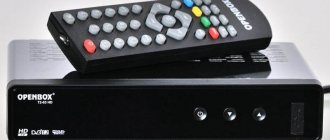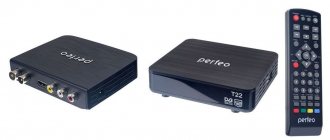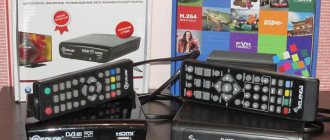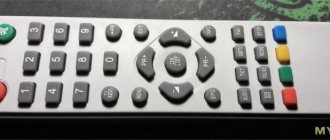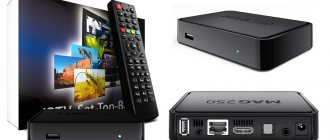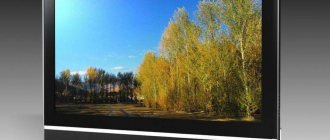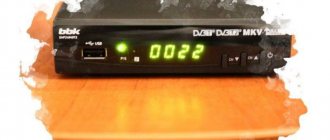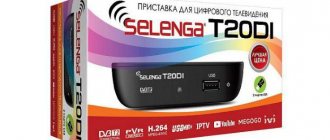Analogue broadcasting is being replaced by digital TV, which today is available to almost every resident. It offers viewing of live TV channels in high definition. However, with the increase in quality, the volume of information has also increased. Therefore, the signal is not transmitted directly, but is pre-encoded into a digital signal of the DVB standard.
To watch digital TV you need to decode the signal. This function is performed by a decoder, which in modern TVs uses a TV tuner, with which you can select the broadcast standard. Old TVs are not able to decipher the signal and to view the numbers on it you will need a digital set-top box (receiver).
Purpose of the device
The main task of any digital receiver is to decipher the DVB standard signal and transmit the finished image to the screen. Depending on the broadcast format and variety, a digital set-top box can perform other tasks:
- Television control. The presence of basic functions for setting up and switching TV channels. Control is carried out using the remote control and (or) the dashboard.
- Reception of different broadcast standards. Universal set-top boxes can simultaneously receive cable, terrestrial and satellite broadcasts. They are designed to receive both digital and analogue broadcasts.
- IPTV. The ability to watch and control television using wired Internet technology. These receivers have a LAN connector for an Ethernet cable. Depending on the set of functions and software, the set-top box can only include an IPTV scanner or provide full Internet access with access to remote services. In the latter case, the equipment refers to Smart set-top boxes.
Each type of console has its own main advantages and disadvantages. Their functions are determined by the complexity of the equipment, on which the cost depends:
- Budget receivers. In most cases, the numbers are designed for one specific broadcast format (terrestrial, cable or satellite TV) and include a minimum number of connectors. Often there is no dashboard, and control is only available from the remote control. Their advantage is the low cost and compactness of the device. The disadvantage is that they are simple decoders that have virtually no additional capabilities.
- Universal receivers. They are represented by set-top boxes that are suitable for receiving digital broadcasts of any standard. Moreover, they can support analog and digital television simultaneously (for example, satellite or terrestrial broadcasting). Their versatility is their advantage - to change the TV format, the user only needs to change the receiver and configure the channels on the previous set-top box. The only disadvantages include the large size. Universal set-top boxes include a large number of decoders and inputs for different digital standards and there are no compact models.
- Smart receiver. With this set-top box, the user can replace a player or even a home theater. Their main advantage is Internet access with access to third-party resources. The disadvantages are the high price of the devices and costly maintenance (repairs).
IPTV is necessarily supported by all Smart set-top boxes, but can also be present in universal devices. In this case, the receiver will only have a LAN connector without support for full Internet access.
When is a digital receiver needed?
Do you need a receiver for modern TVs? The answer to this question depends on two factors:
- user preferences for a specific type of television (terrestrial, satellite, cable);
- functionality of the television receiver (the presence of built-in modules that support the desired format).
If the model does not meet the consumer’s requirements, then the problem can be solved by connecting the appropriate decoder model.
How can you tell if your TV can receive digital without a decoder? Information about the presence of a tuner should be found in the technical documentation for the model or from the description on the manufacturer’s website. The second method does not require studying the instructions. To inform our compatriots, federal channels broadcasting in analog format will be marked with the letter “A” added to the channel logos.
If this letter appears on the screen when watching TV programs, it means that the viewer is using an outdated TV model or has not yet switched to a new signal reception technology.
Broadcast Standards
Digital television developed in parallel with computer technology, as a result of which several digital formats appeared at once, each of which broadcasts according to a specific standard:
- Cable TV. The signal is transmitted wired using a cable and without the use of a receiving device. Broadcasting takes place according to the DVB-C standard.
- Satellite TV. One of the broadcasting standards in which the transmitter is a satellite. The broadcast is carried out with a digital signal of the DVB-S/S standard
- Terrestrial TV. Stationary ground towers - repeaters - are used as transmitters. Broadcasting is free and according to the digital standard DVB-T/T2.
There is also interactive television (IPTV) with high-definition image transmission. It is often also referred to as digital television, which is a mistake. In this case, as with analogue broadcasting, information is transmitted directly, without prior encoding into a digital standard.
For digital cable television you only need a set-top box. The operator whose channel package is connected is responsible for the support and reception of television. Satellite and terrestrial television is broadcast in the decimeter range, which corresponds to frequencies from 0.3 to 3 GHz. At the same time, different broadcasting standards do not overlap and occupy different ranges: up to 800 MHz is used by ground stations, and satellites are installed at frequencies from 1 GHz. Consequently, a set-top box with a decimeter terrestrial antenna will not be able to catch a signal of the DVB-S/S2 standard.
Telefunken TF-DVBT206
Another good model from Telefunken is TF-DVBT206. If we look at several of the latest receivers from this manufacturer (TF-DVBT204 and TF-DVBT205), we can note progress and changes for the better in the functionality and design of TV tuners from this brand.
Main advantages
- High sensitivity: the receiver “catches” the signal even if its intensity drops to a level of 30%
- Works with terabytes of data on external media and easily “pulls” films weighing 15-20 gigabytes
- Images in Full HD quality are reproduced smoothly and without defects
Minuses
- A “glitch” was noticed when, when using a media player, sounds appeared in the form of “clicks” and “crackles”
- The buttons located on the body are difficult to press
- No sequential video playback feature
- A special TV program in EPG format is difficult to understand because the font is small
Criteria for selecting a console
You need to purchase a receiver based on its capabilities and cost. Of course, it is better to buy functional models, but purchasing a more advanced receiver may be a pointless waste. Each console has a lot of criteria by which they differ.
But for greater understanding, they can be combined into two groups:
- Hardware specifications. The general contents of the set-top box (panel, ports, slots, video adapter), which determine the possibilities of its use.
- Software functions. The electronic capabilities of the device, which are largely limited by software.
Regardless of the price category and required functions, for all receivers there are a number of rules that should be followed when choosing:
- Broadcast standard. If you are choosing a set-top box for a specific digital TV, you need to clarify which generation of broadcast format a specific model supports. For example, if the device only decodes the DVB-T digital broadcasting standard, then receiving a DVB-T2 signal will become impossible. This issue is not relevant for cable television, because from the beginning of its launch and to this day, the only standard DVB-C is in force.
- TV screen resolution. The quality of the received image depends on it. If the receiver receives a signal to broadcast at a higher resolution, it will still be reduced in the TV. Therefore, there is no point in purchasing a set-top box, for example, with Full-HD support, if the capabilities of the TV screen are not designed for this format.
Hardware requirements
Each digital TV set-top box is first and foremost a decoder. Therefore, the device must decrypt a digital signal of a standard that matches the broadcast format:
- terrestrial TV - DVB-T/T2,
- satellite TV - DVB-S/S2,
- cable TV - DVB-C;
Each receiver also includes an antenna input and a connector required to connect the set-top box to the TV. When purchasing a satellite receiver, you need to choose a model with a CAM module (slot for an operator card), because Without it, watching paid channels will become impossible.
The choice of set-top box for interactive TV should be taken especially seriously:
- A LAN connector is required. Without it, the receiver cannot be connected to the Internet.
- Video adapter memory. It is analogous to a computer video card and the ability to obtain images in higher resolution depends on its power.
- Amount of built-in memory (CPU). It determines how much information can be stored without an external drive.
- If the receiver is selected for viewing and playing digital and multimedia video formats, it must have a USB port.
Types of ports
Each digital television set-top box includes a group of inputs and connectors. Each has its own purpose and their presence directly affects the capabilities of the receiver. On the panel of each set-top box there is always an antenna input and ports for connecting a “tulip” cable (RCA), or an alternative Scart wire.
Modern models of TVs and set-top boxes are connected using an HDMI cable, which has a higher bandwidth. Older analogues can only support AV connection using a double wire with a white and yellow plug.
The panel of Smart set-top boxes also has a VGA or D-SUB connector for connecting a monitor via a video adapter. The third required input is a USB connector, with which you can connect another device or increase the receiver's memory.
Media formats
Today, there are more than a dozen video file formats that support displaying images in different resolutions. To be able to play them, the set-top box must recognize all formats. Simple and inexpensive digital decoders have a limited set of supported formats - mainly mpeg-4 (mp4) and Full-HD (1080p). However, it is worth considering the capabilities of the TV.
If its maximum capabilities are HDTV image format (720p), then broadcasting in Full-HD resolution will transmit the image in the same quality.
This is a system limitation of the TV, and the issue of low picture quality can only be resolved by purchasing another monitor.
Modern universal set-top boxes, designed for broadcasting in high definition, can now deliver broadcasts in 4K quality (4000p).
Set-top boxes that support playback of files from media can play audio and video in mkv, avi, AC-3, AAC, mpeg-2 and others formats. Smart receivers with full Internet access have the ability to download video codecs from third-party services to play video in a previously unknown format.
Software
Its service capabilities and possible repair costs directly depend on the firmware of the receiver. As a rule, Smart set-top boxes have software that includes access to third-party services and synchronization. This allows the user to update existing applications when a new version is released, as well as reinstall the firmware itself if it is outdated or faulty.
Inexpensive models do not have the ability to update and pre-install, which is why any malfunction in the software will require repairs. Also, if there is no Internet connection or USB port, updating the service is only possible at a service center.
Interface and features
Inexpensive set-top boxes include only basic functions, namely:
- signal decoding;
- setting up channels;
- hardware installations;
- View protection (password setting).
For infrequent viewing, this will be enough, but if you connect interactive TV, you will need an Internet connection. For universal set-top boxes, it is also necessary to have several user modes.
The interface of budget set-top boxes is mainly represented by system settings, user settings and information menus (time, country, program guide).
Smart set-top boxes have their own main menu, in which the user is offered several options:
- watching television;
- working with a remote service;
- synchronization and updating of applications;
- viewing files from the drive;
- etc.
The interface's capabilities are technically unlimited and can be comparable to the options of a personal computer, depending on the specific receiver model.
How to choose the best DVB-T2 set-top box
To set up free channels, use a digital television set-top box. To choose the right receiver, you need to understand broadcast standards. Recently, DVB-T2 has fully replaced DVB-T. The vast majority of models support both standards.
Almost all TVs released after 2013 support these standards, as they are equipped with the appropriate module. All this is described in the specifications. However, if you are using an old TV, then you need to buy a digital DVB-T2 set-top box that connects to the TV.
Experts advise buying receivers that have a CI encoding slot. Right now there is no urgent need for this slot, but in the near future multiplexes will expand and paid channel packages will appear. Therefore, support for this standard can be a useful addition. It is possible that the CI standard will be updated to CI+. Tricolor TV subscribers have already encountered something similar.
Audio codecs also differ depending on the receiver model. If you plan to play content in .avi and .mkv formats, then you need to buy equipment that supports AC-3. Otherwise, the picture will be broadcast on the screen, but the sound will not.
The presence of an HDMI interface is another fundamentally important aspect. When connecting the receiver through this connector, the image quality can be much higher. It is possible that in the near future channels from the third multiplex will be available, which will be broadcast in HD format.
Review of inexpensive digital set-top boxes
Budget receivers are in great demand. This is due not only to the price, but also to the preference to choose a set-top box only for habitual TV watching, while still using a computer for more complex tasks. Therefore, below we will present a rating of popular budget receiver models, which, according to user ratings, are considered the best today.
LUMAX DV-1110HD
Cheap digital TV set-top box with support for 20 digital channels. Excellent for receiving over-the-air broadcasts. The inputs include HDMI, RCA and AV connectors. Consequently, the receiver perfectly recognizes old TVs and transmits the image in high quality. There is a US port for viewing video files, which is also used for automatic software updates.
Advantages: low price (from 900 rubles), the set-top box can be connected to a TV of any generation, low power consumption (8 W).
Disadvantages: does not support analog TV and digital radio broadcasting.
Oriel 421
A small set-top box for 20 TV channels with support for a DVB-T2/C decoder. There is a USB port, the largest video hosting Youtube is available with Google account synchronization. Interactive TV is also available via Wi-Fi router. At the moment this is the cheapest Smart set-top box.
Advantages: low price (from 1100 rubles), Full-HD support (including on the Youtube channel).
Disadvantages: only 20 channels (which is not enough for terrestrial + cable television), IPTV support only using wireless Wi-Fi, which is several times slower than wired Internet.
DEXP HD 1813P
Device for receiving DVB-T/T2 terrestrial TV with 20 channels. There is a USB port and HDTV support. There is a built-in Wi-Fi module for automatic software updates and synchronization. The peculiarity of this model is the automatic search for a lost channel - if the broadcast of one of the programs is stopped, the receiver, using synchronization, will independently search in case the broadcast frequency changes.
Advantages: most functions are automated, no overheating during prolonged operation, metal case. Disadvantages: no Full-HD support, delay when switching programs.
Selenga T81D
Miniature Combo device with support for cable and terrestrial digital TV, as well as radio broadcasting. Supports most audio-video file formats. There is a Wi-Fi connection, but it is only used for software updates and downloading new codecs. There is synchronization with a remote service to receive updates and set the clock (date/time).
Advantages: small dimensions and stylish shape, connector for connecting an external drive, powerful GX3235S processor with high performance.
Disadvantages: IPTV is represented only by a scanner; there is no full Internet connection.
BBK SMP123HDT2
An inexpensive device for the lazy and those who are encountering digital television for the first time. There are two inputs for the tulip and the hgmi module. When connecting each, the quality is almost the same, but depends more on the TV. The interactive proprietary InErgo menu from the manufacturer is easy to set up, thanks to which the user can quickly connect digital TV and set up channels regardless of skills.
Advantages: ease of control, support for Full-HD and digital radio (with mpeg-2 audio and mpeg-4 image).
Disadvantages: only supports mpeg-2 audio codecs, delay when switching channels.
D-color DC1302HD
An excellent receiver for watching digital TV standard DVB-T/T2 and watching any video files. The set-top box does not have built-in memory, but has a USB input for connecting an external drive.
Advantages: compactness, reliable reception from an indoor antenna, Full-HD support.
Disadvantages: delay when switching programs, short network connection cord.
Galaxy Innovations Uni
Budget model Smart set-top box running Android OS. There are two USB inputs and a LAN port. The user has a built-in player and 1 GB of RAM at his disposal. Supports playback of any multimedia files, no additional codecs required.
Advantages: powerful Amlogic S805 Cortex A5 1.5 GHz processor and Internet access, support for any audio files of any format.
Disadvantages: there is no support for pre-installing applications, there is no dashboard control panel (only from the remote control).
Advice before choosing
A budget set-top box must justify itself completely, i.e. be less expensive and provide the user with high-quality TV.
To do this, several criteria should be taken into account:
- Software limitations. If you are purchasing a set-top box for digital television and analogue broadcasting, it is better to consider devices that support more than 20 channels, and for recording files it is better to opt for large RAM.
- Hardware limitations. If you are not confident in the quality of terrestrial TV, it is better to immediately buy a universal receiver with support for a CAN module. Satellite TV may remain the only digital TV option in remote areas.
- Third Party Restrictions. The capabilities of the receiver should not exceed the TV, otherwise its functions will become useless.
Only after determining these criteria should you consider how to choose a TV set-top box based on cost and quality.
All receivers include:
- head device,
- remote control,
- set of necessary cables,
- manual,
- warranty card.
D-Color DC1302HD
One of the best TV tuners currently on the market. The D-Color DC1302HD has a solid metal body, it dissipates heat well, which is why the receiver heats up less, and it is also non-staining. There are on and off buttons on the body, as well as gear shift buttons. It turns out that if the control panel is lost or broken, you will not be left with a useless box, but will be able to continue to use it.
Main advantages
- The set-top box supports AC3 and all video files in MKV format are played correctly
- 24 month warranty period
- The device is quite easy to set up and operate.
- The device responds a little better to signals (commands) from the remote control than other set-top boxes
Minuses
- Very short power cord
- The console menu needs to be made more user friendly
- The set-top box freezes for 20 seconds when switching channels sequentially, and when it hangs, a random violation of program numbering occurs
- If you receive a signal on a bad antenna, strange jumps in the digital signal level begin: fluctuations occur within the range of 0-100%
- Inconvenient remote control with small buttons
- The new firmware update did not make any noticeable changes to the functioning of the device
Multifunctional receivers
They are used as universal Combo devices for decoding any digital signals, as well as viewing analog and interactive television. The choice of such a set-top box is often made with the expectation of getting a device that is suitable for all occasions.
Therefore, such a receiver must have:
- USB input. It is used to record and view multimedia files from an external drive, update software or connect additional devices.
- CAM module. Slot for provider card and bank card. Used to unblock paid satellite TV channels and make online purchases.
- LAN connector. At a great distance from the tower, wireless distribution may be at low speed; in this case, only wired Internet can guarantee stable interactive television without freezes.
Without these hardware capabilities, the functionality of a universal set-top box is significantly reduced, which imposes a number of unpleasant restrictions for the user. For example, without a CAM module, it is impossible to unblock satellite channels, and the lack of a LAN connector can completely deprive you of high-quality IPTV.
It is difficult to determine which set-top box you need to watch digital interactive television, because... They are all multifunctional and it is better to check the set of options with the sellers.
BBK SMP242HDT2
The BBK company is famous for its electronic equipment, and many consumers prefer this company over and over again. In the segment of digital terrestrial television receivers, BBK has already released a whole collection of set-top boxes that differ only by three digits in the middle of the model names. Their differences are not significant, and the possibilities coincide in almost everything. Only one model from this manufacturer was included in our rating. BBK SMP242HDT2 turned out to be a little more reliable than the others, but it also has almost the entire set of shortcomings characteristic of this model range.
Main advantages
- Multifunctional media player capable of “digesting” many video formats
- Equipped with a USB connector, which allows you to connect flash drives to it and launch video files directly from there
- The receiver provides reliable reception of a digital signal even if its quality drops to 50-60%
- Very compact and therefore takes up little space
- The set includes a regular “tulip” cable, which means the set-top box can be connected to a TV or monitor that is not equipped with a modern HDMI connector
Minuses
- Due to the fact that the set-top box is very light, it can be accidentally dropped if you accidentally touch a wire
- Not such a beautiful design, which is sometimes the case with such devices
- “tulips” that come with the console are of poor quality and may naturally require replacement
- High percentage of defects
Popular questions
Is it possible to connect the receiver to a monitor?
Surprisingly, the question “How to connect a monitor to a digital TV set-top box” worries many. Of course, this is not the best use for this device. But it is still possible. The monitor must be disconnected from the computer. An HDMI cable is suitable for connection. If the display has other connection interfaces, you will have to look for an adapter. The only problem is that not all monitors have built-in speakers, so there may be problems with sound transmission.
Can I watch free digital channels without a set-top box?
How to connect digital television without a set-top box? You do not need a set-top box if you watch digital broadcasts via cable television. The cable is pulled directly into the video input port without the use of additional equipment. Also, all modern TV models (produced, as a rule, since 2013) already have a built-in receiver that works with the DVB-T2 standard. So before you spend money on a purchase, check whether your TV model requires additional equipment.
How much does a digital set-top box cost?
It all depends on what functions are needed. If you want to save money and get access to 20 free channels, then an inexpensive model that works according to the DVB-T2 standard is suitable. The cost is within 1000 rubles.
If you want to get additional options such as delayed viewing, rewinding, teletext and TV program guide, look for devices within 2 thousand. For the same price you can find models that can connect to the Internet using a built-in or external Wi-Fi adapter.
The starting price for set-top boxes with Smart-TV is 3,000 rubles. Modern models with a high-speed processor, a built-in hard drive and other bells and whistles cost from 6,000 rubles.
The best premium TV tuners
Most high-price set-top boxes are due to their long service life, a huge list of additional tools, stable operation, support for the vast majority of TV broadcast formats and attractive design.
| Name | Description | Advantages | Flaws | Price |
| SEZAM MARVEL | The set-top box is directly designed for watching online TV, since synchronization is possible not only with a TV, but also with a desktop computer. A wide range of tools will give you an unforgettable driving experience. |
|
| from 5680 rubles |
| DIGIFORS SMART 200 ANDROID | An ideal option for users who prefer to watch movies of the best quality and often use a smartphone. The set-top box is equipped with tools that duplicate the capabilities of the Android operating system. |
|
| from 2900 rubles |
| AVerTV HYBRID VOLAR T2 | A unique device with powerful hardware, high performance and a memorable design. The receiver can be synchronized with the Windows operating system, and then used as a router. Reliable and durable device. |
|
| from 4970 rubles |
| GALAXY INNOVATIONS UNI 2 | A distinctive feature of this receiver is the use of the Android 7 operating system. The device can be used to watch TV and surf the Internet. Despite the complex system, the controls are quite simple. |
|
| from 2890 rubles |
